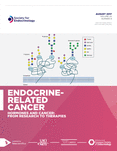Synthetic lethality: the road to novel therapies for breast cancer
- 1Fred Hutchinson Cancer Research Center, Seattle, Washington, USA
- 2The CRUK Gene Function Laboratory and Breast Cancer Now Toby Robins Research Centre, The Institute of Cancer Research, London, UK
- Correspondence should be addressed to C J Lord or T Taniguchi; Email: chris.lord{at}icr.ac.uk or ttaniguc{at}fredhutch.org
Abstract
When the BRCA1 and BRCA2 tumour suppressor genes were identified in the early 1990s, the immediate implications of mapping, cloning and delineating the sequence of these genes were that individuals in families with a BRCA gene mutation could be tested for the presence of a mutation and their risk of developing cancer could be predicted. Over time though, the discovery of BRCA1 and BRCA2 has had a much greater influence than many might have imagined. In this review, we discuss how the discovery of BRCA1 and BRCA2 has not only provided an understanding of the molecular processes that drive tumourigenesis but also reignited an interest in therapeutically exploiting loss-of-function alterations in tumour suppressor genes.
- Received 12 August 2016
- Accepted 15 August 2016
- Made available online as an Accepted Preprint 15 August 2016
- © 2016 Society for Endocrinology












